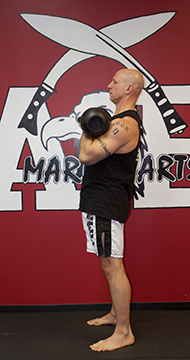 The Kettlebell Clean is often overlooked as an essential exercise because it lacks the “sexiness” of the Swing and Snatch, the power of the Squat and Press and it does not stimulate the intrigue of the Turkish Get-up. However, couple your Swings with Cleans or perform a chain with a Swing, a Clean and a Snatch and you’ll have some great routines. Also, if you want to perform your Presses and Squats, how will you get your Kettlebells into the Racked position? You got it, The Kettlebell Clean.
The Kettlebell Clean is often overlooked as an essential exercise because it lacks the “sexiness” of the Swing and Snatch, the power of the Squat and Press and it does not stimulate the intrigue of the Turkish Get-up. However, couple your Swings with Cleans or perform a chain with a Swing, a Clean and a Snatch and you’ll have some great routines. Also, if you want to perform your Presses and Squats, how will you get your Kettlebells into the Racked position? You got it, The Kettlebell Clean.
In all of it’s simplicity, the Clean is more often performed incorrectly. This results in bruised wrists, strained biceps, elbows or forearms as well a faulty rack incapable of providing a stable starting point for your Press or Squat. Also, casting of the Kettlebell on the descent will place undue stress on the low back and possibly result in a face-plant!
Simply put, a Clean is nothing more than a Swing with your elbows pinned to your sides. There is no jerking up into the position, nor is there a “curling” of the bell into the rack (try to use that method to rack the Beast and let me know how many pieces you shred your bicep into). I have also found that teaching people how to Clean two kettlebells at once is easier. The students don’t have to be concerned with over rotating one hip and they are also psyched about using two Kettlebells at the same time. Once they have the idea that the Clean is identical to the swing at the start point, exhale and hip movement, the Clean becomes easier to perform. Pay particular attention to the breathing aspect. The breath of the Clean occurs at the exact point as your exhale while performing the Swing – at the top of the hip motion when your knee caps are drawn into your quads and your legs are locked. The sharp exhale does not occur when the Kettlebells are in the Rack, it happens slightly before. This simple tip will significantly reduce the amount of “smashing” that occurs on your wrists. At this point, the top of the Swing portion of the clean, you stop pulling and allow the Kettlebells to “float” into position. The float will occur only when your breath is timed correctly and you allow the bells to achieve the Rack position without using your arms to pull.
If you find that you are “curling” the bell during your Cleans, use a heavier bell. This will cure many issues because you will not be able to “curl” a heavier bell into position. Once your technique improves, you should be able to execute proper form of your Cleans with any sized bell. For one to attain mastery of the Clean, the technique should look identical, regardless of the size of the Kettlebell.
There are also several extremely beneficial variations of the Clean. Alternating Cleans provide an incredible core workout, Bottoms-up Clean and Hold are one of the best grip development exercises available. Have Cleans as part of any Chain or Complex for a transitory or additional movement to enhance the circuit.
The Kettlebell Clean is not only essential for transitions from one movement to another, but it is an incredible exercise for going from ballistic to static to ballistic again. The athletic application from the Clean is is beneficial for development of power for strikes, throws, synergy of upper and lower body movements, not to mention the incredible way it develops superior core strength.
Strength & Honor,
Coach Phil
***
About Master RKC Phil Ross: Master RKC, 8th Degree Black Belt, Specialist in Bodyweight Strength, PCC and CK-FMS Certified. His name is synonymous with Martial Arts and Fitness. He is known as the area’s Kettlebell King and has successfully competed on the National Level in… Read more here.